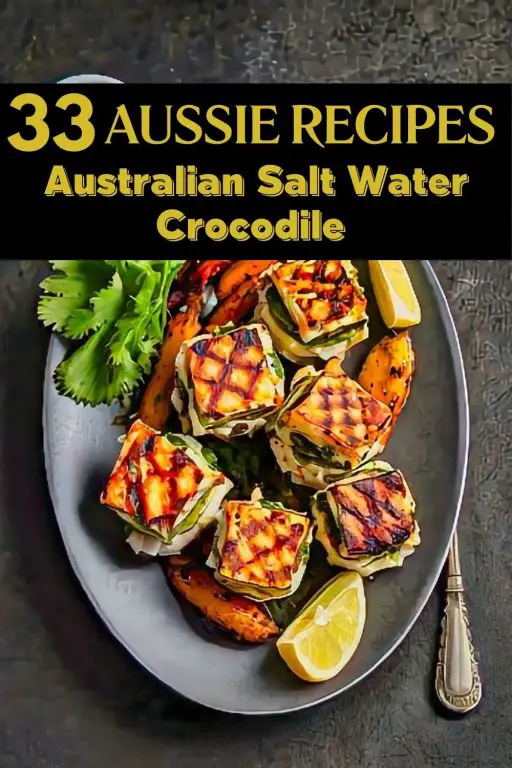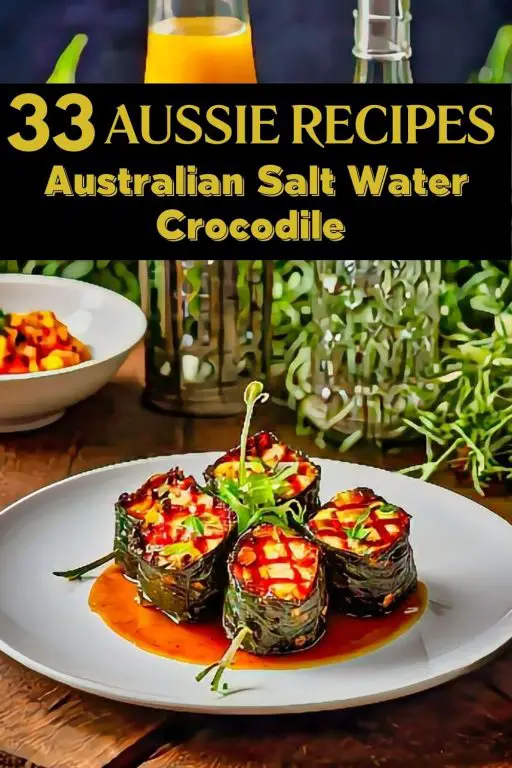Notice: It is illegal to kill wils Salt Water Crocodiles. Farm raised crocodile meat is vital industry to many in Australia and a sustainale food source for many.
The Australian Salt Water Crocodile recipe was the focus of a cooking class I attended. The Australian Salt Water Crocodile recipe involves grilling the crocodile meat, which is known for its firm, white flesh. The Australian Salt Water Crocodile recipe resulted in a dish with a texture similar to chicken but with a slight fish-like quality. The meat remained tender and light in appearance once cooked.
As we worked through the Australian Salt Water Crocodile recipe, we noticed that the grilling process gave the meat a slight char on the outside, adding to its visual appeal. The recipe produced a dish that was lean, with the flesh staying firm even after cooking. The Australian Salt Water Crocodile recipe highlighted the unique makeup of the meat, which didn’t have the same fat content as other meats, resulting in a light, clean flavor. This recipe demonstrated how the meat holds its shape well when grilled and can be served with minimal preparation.
After completing the Australian Salt Water Crocodile recipe, we asked the instructor for a copy of the steps to recreate the dish. This experience provided a good understanding of how to work with crocodile meat using a simple grilling method.

Ingredients For the Australian Salt Water Crocodile Recipe
Farm Raised Saltwater Crocodile Tail Meat
All-Purpose Flour
Salt
Ground Black Pepper
Paprika
Garlic Powder
Olive Oil
Butter
Onion, chopped
Minced Garlic
Chicken Broth
Dry White Wine
Lemon Juice
Capers
Chopped Fresh Parsley
Cooking Instructions For the Australian Salt Water Crocodile Recipe
- In a shallow dish, mix together the flour, salt, black pepper, paprika, and garlic powder. Dredge the crocodile tail meat in the flour mixture, shaking off any excess.
- In a large skillet, heat the olive oil over medium-high heat. Add the butter and let it melt. Add the crocodile meat to the skillet and cook until browned on all sides, about 5-7 minutes. Remove the meat from the skillet and set it aside on a plate.
- Add the onion and garlic to the skillet and cook until softened, about 2-3 minutes. Pour in the chicken broth, white wine, and lemon juice, and bring to a boil. Reduce the heat and let the sauce simmer for 10-15 minutes until it thickens.
- Add the capers and parsley to the skillet and stir to combine.
- Return the crocodile meat to the skillet and coat it with the sauce. 11. Let the meat cook for an additional 5-10 minutes until heated through and the sauce has thickened.
- Serve the crocodile meat hot with the sauce spooned over it. Enjoy your delicious Australian Salt Water Crocodile dish!
Eating Healthy in Australia
Eating healthy in Australia is supported by a variety of factors, including access to fresh produce, a diverse range of dietary options, and a strong emphasis on nutrition. The Australian food culture promotes balanced eating habits and offers numerous opportunities to incorporate healthy choices into daily life.
Australia’s climate is ideal for growing a wide array of fresh fruits and vegetables. Local markets and grocery stores are abundant with seasonal produce like apples, oranges, berries, leafy greens, and root vegetables. These fresh ingredients are often featured in traditional Australian meals, such as salads, vegetable stir-fries, and fruit-based desserts.
Protein sources in Australia also support a healthy diet. Lean meats such as chicken and kangaroo are commonly consumed, providing essential nutrients without excess fat. Seafood, including barramundi and prawns, is another healthy option, rich in omega-3 fatty acids and low in saturated fat. Many Australians also incorporate plant-based proteins, such as legumes, nuts, and seeds, into their diets, reflecting a growing awareness of vegetarian and vegan nutrition.
The Australian dietary guidelines recommend a balanced intake of various food groups, emphasising whole grains, healthy fats, and limited added sugars and saturated fats. The Mediterranean-style diet, which is popular in Australia, aligns with these guidelines by focusing on fruits, vegetables, whole grains, and healthy fats like olive oil.
Moreover, Australia’s food culture promotes hydration with a strong emphasis on drinking water. The country’s clean water supply makes it easy to stay hydrated, an essential aspect of maintaining overall health.
In recent years, there has been a significant increase in the availability of health-conscious products and resources, including organic foods and dietary supplements. This shift reflects a growing public interest in wellness and a commitment to making healthier food choices.
Overall, Australia’s focus on fresh, diverse, and nutritious foods contributes to a healthy eating environment, supporting individuals in making balanced dietary decisions.
Most Popular Spices For Australian Cooking
1. Tasmanian Pepperberry: This native spice has a unique, spicy kick with a hint of fruitiness. It’s often used in marinades, sauces, and as a seasoning for meats and vegetables.
2. Wattleseed: Known for its nutty, coffee-like flavour, wattleseed is used in both sweet and savoury dishes. It’s often incorporated into baked goods, sauces, and as a seasoning for meats.
3. Bush Tomato: Also called desert raisin, bush tomato has a strong, tangy flavour. It’s used in chutneys, sauces, and spice blends, adding a distinctive Australian touch to dishes.
4. Native Mint: This spice has a refreshing, minty flavour with herbal undertones. It is used in a variety of dishes, from salads to meats, to provide a fresh and aromatic element.
5. Finger Lime: Though more commonly used as a fruit, finger lime zest can be used as a spice to add a citrusy, zesty flavour to dishes. It pairs well with seafood and salads.
6. Coriander: Coriander seeds are widely used in Australian cooking, particularly in spice blends and as a seasoning for meats and vegetables. Its warm, slightly citrusy flavour enhances a variety of dishes.
7. Cumin: Cumin adds a warm, earthy flavour to dishes and is frequently used in curries, stews, and spice blends. It’s a versatile spice that complements many Australian recipes influenced by global cuisines.
8. Paprika: Often used for its mild, smoky flavour, paprika is popular in Australian cooking for seasoning meats, adding colour to dishes, and enhancing the overall flavour profile of recipes.
9. Turmeric: Known for its bright yellow colour and warm, slightly bitter flavour, turmeric is used in curries, stews, and rice dishes. It’s valued for both its flavour and health benefits.
10. Chili Flakes: Adding heat and spice, chili flakes are used in various Australian dishes, from barbecue sauces to stir-fries, providing a kick that enhances the overall taste.
FAQ For the Australian Salt Water Crocodile Recipe
Q: What is an Australian Salt Water Crocodile recipe?
A: An Australian Salt Water Crocodile recipe involves cooking the meat of the saltwater crocodile, a unique and exotic ingredient. The Australian Salt Water Crocodile recipe typically includes marinating or seasoning the crocodile meat before grilling, roasting, or pan-searing to enhance its flavour and tenderness.
Q: What ingredients are needed for an Australian Salt Water Crocodile recipe?
A: The ingredients needed for an Australian Salt Water Crocodile recipe usually include saltwater crocodile meat, olive oil, garlic, lemon juice, herbs, and spices. The Australian Salt Water Crocodile recipe uses these ingredients to create a flavourful and succulent dish.
Q: How do you prepare the crocodile meat in an Australian Salt Water Crocodile recipe?
A: To prepare the crocodile meat in an Australian Salt Water Crocodile recipe, start by marinating it in a mixture of olive oil, garlic, lemon juice, and desired herbs and spices. Let the meat marinate for a few hours to absorb the flavours, then cook it using your preferred method, such as grilling or pan-searing. The Australian Salt Water Crocodile recipe ensures the meat is tender and well-seasoned.
Q: Can the Australian Salt Water Crocodile recipe be made in advance?
A: Yes, the Australian Salt Water Crocodile recipe can be made in advance. You can marinate the crocodile meat ahead of time and store it in the refrigerator until you’re ready to cook. Once cooked, the Australian Salt Water Crocodile recipe can also be refrigerated and reheated when needed.
Q: What are some serving suggestions for the Australian Salt Water Crocodile recipe?
A: Serving suggestions for the Australian Salt Water Crocodile recipe include pairing it with a fresh salad, grilled vegetables, or a tangy dipping sauce. The Australian Salt Water Crocodile recipe can also be served alongside rice or potatoes to create a complete and satisfying meal.

Australian Salt Water Crocodile
Equipment
- Large Skillet
- Shallow dish
- Cutting board and Chef's knife
- Measuring cups and spoons
Ingredients
- 2 lbs. Australian saltwater crocodile tail meat, cut into small pieces
- 1/2 cup all-purpose flour
- 1/2 tsp salt
- 1/2 tsp ground black pepper
- 1/2 tsp paprika
- 1/2 tsp garlic powder
- 1/4 cup olive oil
- 1/4 cup butter
- 1 onion, chopped
- 2 cloves garlic, minced
- 1 cup chicken broth
- 1/2 cup dry white wine
- 2 tbsp. lemon juice
- 2 tbsp. capers
- 1/4 cup chopped fresh parsley
Instructions
- In a shallow dish, mix together the flour, salt, black pepper, paprika, and garlic powder.
- Dredge the crocodile tail meat in the flour mixture, shaking off any excess.
- In a large skillet, heat the olive oil over medium-high heat. Add the butter and let it melt.
- Add the crocodile meat to the skillet and cook until browned on all sides, about 5-7 minutes.
- Remove the meat from the skillet and set it aside on a plate.
- Add the onion and garlic to the skillet and cook until softened, about 2-3 minutes.
- Pour in the chicken broth, white wine, and lemon juice, and bring to a boil.
- Reduce the heat and let the sauce simmer for 10-15 minutes until it thickens.
- Add the capers and parsley to the skillet and stir to combine.
- Return the crocodile meat to the skillet and coat it with the sauce.
- Let the meat cook for an additional 5-10 minutes until heated through and the sauce has thickened.
- Serve the crocodile meat hot with the sauce spooned over it.
- Enjoy your delicious Australian Salt Water Crocodile dish!




3 comments
Perfectly seasoned and cooked to perfection. This recipe is a winner!
I cant believe theyre promoting cooking saltwater crocodile! Is it ethical to eat such a unique creature? Im all for trying new foods, but this feels wrong. Whats next, kangaroo stew?
I cant believe theyre promoting eating saltwater crocodile as a healthy option in Australia! Isnt there a better way to encourage healthy eating without resorting to such exotic meats? Whats next, kangaroo burgers for weight loss?
Comments are closed.